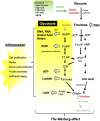Endogenous Fructose Metabolism Could Explain the Warburg Effect and the Protection of SGLT2 Inhibitors in Chronic Kidney Disease
- PMID: 34220855
- PMCID: PMC8243983
- DOI: 10.3389/fimmu.2021.694457
Endogenous Fructose Metabolism Could Explain the Warburg Effect and the Protection of SGLT2 Inhibitors in Chronic Kidney Disease
Abstract
Chronic low-grade inflammation underlies the pathogenesis of non-communicable diseases, including chronic kidney diseases (CKD). Inflammation is a biologically active process accompanied with biochemical changes involving energy, amino acid, lipid and nucleotides. Recently, glycolysis has been observed to be increased in several inflammatory disorders, including several types of kidney disease. However, the factors initiating glycolysis remains unclear. Added sugars containing fructose are present in nearly 70 percent of processed foods and have been implicated in the etiology of many non-communicable diseases. In the kidney, fructose is transported into the proximal tubules via several transporters to mediate pathophysiological processes. Fructose can be generated in the kidney during glucose reabsorption (such as in diabetes) as well as from intra-renal hypoxia that occurs in CKD. Fructose metabolism also provides biosynthetic precursors for inflammation by switching the intracellular metabolic profile from mitochondrial oxidative phosphorylation to glycolysis despite the availability of oxygen, which is similar to the Warburg effect in cancer. Importantly, uric acid, a byproduct of fructose metabolism, likely plays a key role in favoring glycolysis by stimulating inflammation and suppressing aconitase in the tricarboxylic acid cycle. A consequent accumulation of glycolytic intermediates connects to the production of biosynthetic precursors, proteins, lipids, and nucleic acids, to meet the increased energy demand for the local inflammation. Here, we discuss the possibility of fructose and uric acid may mediate a metabolic switch toward glycolysis in CKD. We also suggest that sodium-glucose cotransporter 2 (SGLT2) inhibitors may slow the progression of CKD by reducing intrarenal glucose, and subsequently fructose levels.
Keywords: CKD - chronic kidney disease; The Warburg effect; fibrosis; fructose; inflammation.
Copyright © 2021 Nakagawa, Sanchez-Lozada, Andres-Hernando, Kojima, Kasahara, Rodriguez-Iturbe, Bjornstad, Lanaspa and Johnson.
Conflict of interest statement
ML, LS-L and RJ have equity in a start-up company developing fructokinase inhibitors (Colorado Research Partners LLC). TN and RJ also have equity with XORTX therapeutics which is developing novel xanthine oxidase inhibitors. RJ is also a consultant for Horizon Pharmaceuticals, Inc. BR-I is a recipient of the Cátedra Salvador Zubirán, Universidad Nacional de México and Instituto Nacional de Ciencias Médicas y Nutrición “Salvador Zubirán, Ciudad de México, Mexico. PB has acted as a consultant for AstraZeneca, Bayer, Bristol-Myers Squibb, Boehringer Ingelheim, Eli-Lilly, Sanofi, Novo Nordisk, and Horizon Pharma. PB serves on the advisory boards of AstraZeneca, Boehringer Ingelheim, Novo Nordisk and XORTX. The remaining authors declare that the research was conducted in the absence of any commercial or financial relationships that could be construed as a potential conflict of interest.
Figures


Similar articles
-
Renal Tubular Handling of Glucose and Fructose in Health and Disease.Compr Physiol. 2021 Dec 29;12(1):2995-3044. doi: 10.1002/cphy.c210030. Compr Physiol. 2021. PMID: 34964123 Free PMC article.
-
Fructose in the kidney: from physiology to pathology.Kidney Res Clin Pract. 2021 Dec;40(4):527-541. doi: 10.23876/j.krcp.21.138. Epub 2021 Nov 1. Kidney Res Clin Pract. 2021. PMID: 34781638 Free PMC article.
-
Inhibition of sodium-glucose cotransporter 2 to slow the progression of chronic kidney disease.Acta Clin Belg. 2022 Aug;77(4):805-814. doi: 10.1080/17843286.2021.1966583. Epub 2021 Aug 17. Acta Clin Belg. 2022. PMID: 34404335 Review.
-
Beyond SGLT2: proximal tubule transporters as potential drug targets for chronic kidney disease.Nephrol Dial Transplant. 2025 Feb 5;40(Supplement_1):i18-i28. doi: 10.1093/ndt/gfae211. Nephrol Dial Transplant. 2025. PMID: 39907544 Free PMC article. Review.
-
Effects of sodium glucose co-transporter 2 inhibitors on the kidney.Diab Vasc Dis Res. 2018 Sep;15(5):375-386. doi: 10.1177/1479164118783756. Epub 2018 Jul 2. Diab Vasc Dis Res. 2018. PMID: 29963920 Review.
Cited by
-
Targeting Lactate: An Emerging Strategy for Macrophage Regulation in Chronic Inflammation and Cancer.Biomolecules. 2024 Sep 24;14(10):1202. doi: 10.3390/biom14101202. Biomolecules. 2024. PMID: 39456135 Free PMC article. Review.
-
Tubular Cell Glucose Metabolism Shift During Acute and Chronic Injuries.Front Med (Lausanne). 2021 Oct 29;8:742072. doi: 10.3389/fmed.2021.742072. eCollection 2021. Front Med (Lausanne). 2021. PMID: 34778303 Free PMC article. Review.
-
Responses to Hypoxia: How Fructose Metabolism and Hypoxia-Inducible Factor-1a Pathways Converge in Health and Disease.Curr Nutr Rep. 2023 Mar;12(1):181-190. doi: 10.1007/s13668-023-00452-5. Epub 2023 Jan 28. Curr Nutr Rep. 2023. PMID: 36708463 Review.
-
The fructose survival hypothesis for obesity.Philos Trans R Soc Lond B Biol Sci. 2023 Sep 11;378(1885):20220230. doi: 10.1098/rstb.2022.0230. Epub 2023 Jul 24. Philos Trans R Soc Lond B Biol Sci. 2023. PMID: 37482773 Free PMC article. Review.
-
Handling the sugar rush: the role of the renal proximal tubule.Am J Physiol Renal Physiol. 2024 Dec 1;327(6):F1013-F1025. doi: 10.1152/ajprenal.00265.2024. Epub 2024 Oct 24. Am J Physiol Renal Physiol. 2024. PMID: 39447117 Review.
References
Publication types
MeSH terms
Substances
LinkOut - more resources
Full Text Sources
Medical

